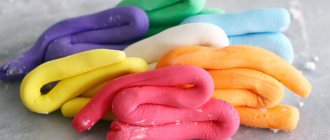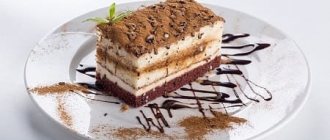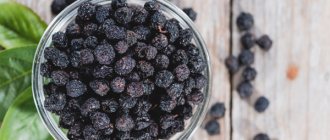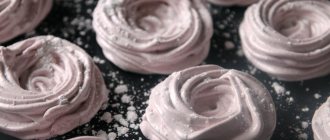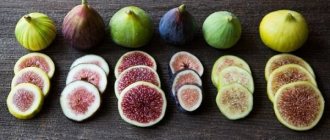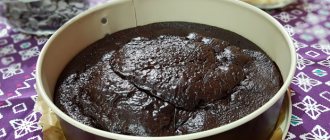Methods for rolling out mastic
Most often, confectioners roll out mastic, which can be purchased at pro-konditer.com, on a surface lightly sprinkled with starch or powdered sugar. But this method is quite complicated, since the rolled out layer must be periodically turned over so that it does not stick to the surface. To make the task easier, you can grease two sheets of dense polyethylene with odorless vegetable oil and roll out the mastic between them. Or a mat with a non-stick surface could be an excellent option.
Mastic at home
First, determine for what purpose you need to make mastic. Dairy (based on powdered or condensed milk), chocolate and marshmallow mastic are suitable for covering cakes. To create figures - chocolate, sugar and marshmallow.
Homemade marshmallow mastic is the most popular and simplest recipe. If you follow all the steps step by step, you will get an almost universal mass.
In total, you need four components - marshmallows (100 g), powdered sugar (250 g), a little citric acid and water.
- Place the marshmallows in a bowl, add a pinch of citric acid diluted in a tablespoon of water.
- Place the bowl in the microwave at maximum power. The marshmallows should melt well.
- Start mixing powdered sugar into the mixture. Work like you would with dough - the mastic should become smooth and elastic.
- Roll the finished lump in powdered sugar, wrap in film and place in the refrigerator for half an hour. After this, you can begin the cake decorating process!
This delicious and simple cake fondant can be easily colored with food coloring. There are two ways to add color to the mass:
- add dye while kneading - this will give you delicate shades;
- color a ready-made cake or figurine. The color will be brighter, you can combine tones and paint complex decorations. But be sure to let the surface dry!
Another type of mastic intended for sculpting jewelry and figurines is gelatin. It is snow-white and hardens quickly. It is good for sculpting trees and bridges. You will need:
- 0.5 tsp gelatin (2 grams),
- 2 tsp water (10 ml.)
- 100 gr. powdered sugar
- a couple drops of lemon juice.
You need to let the gelatin swell in water, then melt it in a water bath. After dissolving, add powder little by little, kneading like dough. Make sure that the mixture does not become too thick - if it starts to crack, add lemon juice.
Working with mastic
Working with mastic is not as complicated a process as it might seem. You just need to take into account a few important rules.
- If you make your own mastic, use high-quality powdered sugar. It should be free of grains - the sugar crystals will cause the mastic layer to tear.
- To glue the fondant decoration onto the cake, moisten the desired area of the surface. Parts of the assembled figures can be glued together with egg white.
- Large figures must be made in advance and allowed to dry.
- Complex and voluminous flowers should be stored in the refrigerator after drying, and glued shortly before serving the cake. Otherwise, they will absorb moisture from the air and may lose their shape.
- To make the surface shiny, brush the cake with vodka 10-20 minutes before serving. The alcohol will quickly disappear and the cake will be shiny.
- Dry and gel dyes are best suited for coloring.
- You can easily color the mastic at the kneading stage by rolling it into a ball and making a depression in the center. The dye is applied with a toothpick. Then knead.
Do not immediately take on complex shapes and figures: cover a round cake, make simple flowers or decorations cut out using shapes.
The nuances of working with mastic for cakes
If you want to cover the cake with mastic, you need to first prepare the surface of the product. Chocolate ganache, butter or caramel cream, and marzipan are suitable for mastic. This “layer” will help the mastic retain its shape: it “floats” from moisture, so it cannot be applied to impregnated cakes or sour cream.
Sometimes it is recommended to cover the top crust and sides with apricot jam. But in this case, the mastic “wrapper” of the cake will swell from moisture.
A few more tips:
- Pre-level the surface: apply the cream, smooth it with a spatula, let it harden in the refrigerator, and then check that the layer is even. Mastic will not hide unevenness.
- It is better not to store the finished cake in the refrigerator for a long time. If you take out a product and it is covered with microdroplets of water, do not wash it, let it evaporate on its own. Otherwise, stains will remain on the mastic.
- Don't roll out the mixture too thin. The ideal thickness is 3-4 mm. The table or board should be sprinkled with powder or starch. A silicone mat will also work well.
Working with cake fondant is easier if you use a few useful tools. These include:
- perfectly smooth rolling pin;
- leveling iron;
- rotating stand;
- roller for trimming edges.
All this can be bought in the section “for mastic and marzipan” on the website of the online store Supermarket for Confectioners
.
Decorating a cake with mastic - how to do it
To make a cake with mastic - simple or complex, there is no need to rush. Then even a novice pastry chef will be able to make his own little masterpiece. The algorithm for a simple cake wrap looks like this:
- roll out a circle of mastic. The diameter of the circle should be approximately equal to twice the height of the cake plus its diameter. Add to this a couple of centimeters “for trimming”;
- roll the mixture onto a rolling pin and transfer it to the cake;
- Smooth the top with an iron, being careful not to stretch the mass. Then smooth out the corners;
- Carefully press down the sides to remove any creases. Walk the iron over the surface;
- trim off the excess with a roller.
On average, a cake with a diameter of 15 cm and a height of 10 will require half a kilo of mastic. And for large ones, with a diameter of 35 cm - two kilograms.
If you didn’t calculate correctly and there are still bubbles on the surface, you can get rid of them by lifting the edge of the layer and laying it down again. If you have leveled the top and moved on to the sides, there is no need to return to it and smooth it further, because the mastic will stretch.
Decorating a cake with fondant can be done using prepared circles exactly along the diameter of the cake and ribbons of a contrasting color for the sides.
A textured surface can be easily created using tongs. Using pastry tongs, like tweezers, “grab” a piece of mastic and pinch it. With this device you can make geometric patterns, leaves, hearts.
Mastic cake decorating ideas
Mastic decorations can be used to decorate cakes of any size. Elements made from this mass go well with sugar beads or pearls, sprinkles and other confectionery decor.
An elegant and simple option is to cover the cake with elongated triangles of pearl fondant. The elements need to be layered on top of each other to create a ruched effect on the fabric. You can place several large sugar beads in the center.
A very effective decoration for mastic cakes is the use of figures cut out with cookie cutters. Snowflakes, hearts, and leaves look good against a contrasting background.
Delicate and very romantic decor - multi-colored “skirts” made of mastic on the sides of the cake. You need to cut out the ribbons, carefully make “assemblies” using a wooden knitting needle or stick and glue them to the cake. For more reliable fastening, you can use needles or pins - when the decoration dries, they can be easily removed. Additionally, you can cut out mastic bows.
You can make “marble” or “zebra” decor from mastic of different colors: contrasting ribbons, thin ribbons should be placed on a mastic circle, and then rolled out until smooth.
Mastic cake secrets for beginners
The best cake layers for a mastic-coated cake are sponge cakes, but there are recipes that allow you to use shortbread and even soufflé. However, if you want to make a soufflé cake, there should be sponge layers on top and bottom. Otherwise, the mastic will flow and the cake will lose its shape.
The basic version for a sponge cake is a dough made from eggs, sugar, flour and butter. Proportions vary depending on the recipe. The cake layered with the selected cream must be placed in the refrigerator for soaking. You can even press it on top with a press so that it takes shape.
Then you need to trim the sides to make it easier to cover with mastic. If the cake is made up of several parts, you need to make the desired shape. For convex elements, you can make a mixture of biscuit crumbs and mastic cream. It’s easy to disguise unevenness with it.
A simple cream recipe - made from butter and condensed milk. Beat a stick of butter with a mixer until a white mass is obtained and add half a can of condensed milk. Whisk again. Cover the cake with cream and put it in the refrigerator. Then use a heated dry spatula to smooth out any unevenness.
You can start covering the cake with fondant!
For beginners, you can apply any design or inscription to a mastic cake using a stencil and special dye or food markers.
Simple flowers are made using cups and other containers of different diameters: circles are cut out, and then the flower is assembled.
Simple mastic cake, basic recipe
If you want to make a cake quickly, the easiest option is to use ready-made cake layers.
Next, you need to “assemble” the product: “Inner” cream, which is used to layer the cakes, you can take almost any one to your taste, for example, creamy, custard, butter.
- To make the cake tastier, the layers can be additionally layered with dried fruits, fresh fruits that do not get soggy, or alternate between cream and sour jam;
- The top layer is covered with butter cream.
- An even simpler option is to use ready-made chocolate spread. You need to heat it slightly so that it spreads better, and then cool the cake in the refrigerator.
- Cover the finished cake with fondant as usual. If the excess mass is trimmed unevenly, the bottom edge of the cake can be decorated with sides or cut out openwork ribbons.
This is the simplest mastic cake, a basic recipe - you can even make it with your children, who will enjoy sculpting from a pliable mass, like plasticine.
In the Supermarket for the pastry chef
You can purchase felt-tip pens for drawing with mastic, equipment for creating flowers and figures, ready-made sweet flowers and much more. You can make your own little confectionery masterpiece in just a few hours.
In this topic, I listed the important points that I encountered myself when working with sugar mastic. I managed to solve some things myself; in some situations I looked for answers on the Internet. I am happy to share my experience! I hope it will be useful to someone.
- What proportions of milk powder and powdered sugar are most ideal to make good mastic? How to choose the right condensed milk(
The ratio of powder and milk powder should be 1:1. It is not the volume of ingredients that is measured, but their weight. You can measure the ideal ratio in a measuring cup by mixing 350 ml of caster sugar with 500 ml of milk powder. The powder and milk should be compacted by tapping the bottom of the measuring cup. In this case, the powder should be sifted through the finest sieve to avoid the ingress of large particles of sugar, which will negatively affect the quality of the mastic (sugar mastic breaks due to this oversight). You need to add enough condensed milk to this mixture so that the mastic is soft and slightly sticky.
Condensed milk must be of good quality. The can should say “Condensed Milk” and not “Condensed Milk”. The composition should contain only milk and sugar, without substitutes or fats in large quantities. otherwise, there is a chance that the mastic will not hold its shape.
- How to work with mastic so that it does not stick to the work surface?
To prevent mastic figures from sticking to the table and dishes during modeling and drying, they should be placed on a surface covered with cellophane or cling film.
- How to paint mastic with dry dyes?
I simply dilute them with lemon juice and add them to the finished mastic for mixing. Sometimes I mix it with lemon juice and condensed milk before kneading the mastic, and then add a mixture of dry milk and powdered sugar. However, I rarely color the mastic completely. More often I cover finished figures made from unpainted mastic with the required color, also diluting dry food coloring in lemon juice.
- How to remove an accidental mistake with food coloring on mastic?
Very simple. It is enough to lubricate the surface with lemon juice and wipe it with a dry brush, which will absorb the colored juice.
- What to do if the mastic has become weathered and turned stony? What can I do to make hardened mastic soft?
To do this, you can simply hold it for 5-10 seconds (depending on the volume of mastic) in the microwave or oven. Once warmed up, the mastic will become soft. I also sometimes use lemon juice to make the hardened mastic suitable for baking again. Just add the required amount of lemon juice to it and knead well. The mastic will crumble, but you shouldn't pay attention to this.
- How and for how long should milk mastic be stored?
Milk mastic must be stored tightly wrapped in a plastic bag to prevent air from entering. Should be stored in the refrigerator. It is advisable to use and eat it within 2-3 weeks, as longer storage will spoil its taste.
- Why doesn't the mastic keep its shape and float?
When making mastic, you must use exclusively milk powder, which should not be fatty. Due to the high percentage of fat content in milk powder, the mastic will turn out crumbly and will leave an oily trace on the surface; the product will not hold its shape. Besides, it will melt before our eyes. The same will happen when using dry cream.
- How to use silicone molds for mastic?
Before use, the silicone mold for mastic must be thoroughly rinsed without using abrasives, and then dried thoroughly. Before putting mastic into the mold, you need to sprinkle its inner surface with food starch, powdered sugar or milk powder. Push the mastic into the mold and put it in the microwave at the highest power for 5 seconds. Food grade silicone tolerates temperatures from -40 to +250 degrees Celsius. The softened heated mastic must be pressed down again to fill the smallest parts of the silicone mold with it. Then put the mold in the freezer until it hardens for 15-20 minutes, depending on the size of the figure. The frozen mastic can be easily removed from the mold.
- What can I do to prevent the cake from showing through the mastic after coating? What cream is used to cover the cake with sugar mastic?
The base to be coated with mastic should not be wet. The mastic should be applied to a dry sponge cake or a sponge cake coated with butter cream. If another cream is used, then a thin layer of marzipan mass, ganache or butter cream should be applied to its surface. Before covering the cake with mastic, place it in the refrigerator until the cream hardens. After coating, avoid too high air humidity when storing the cake. If possible, it should be placed in an airtight container in a cool room.
- What is the optimal thickness when rolling out mastic?
To ensure that the mastic does not tear when covering the cake, does not show through and hides minor surface irregularities, it should not be rolled out too thin. The thickness of the rolled out mastic layer should be about 3 mm.
- How to roll out mastic correctly so that it does not stick or tear?
In my opinion, the most convenient are two ways of rolling out mastic. The first is to roll out the mastic on a surface sprinkled with powder or starch. But I don’t really like this option, since the mastic dries quickly. The second is to roll out the mastic between two polyethylene sheets. In order for the surface of the mastic to be smooth, dense polyethylene should be used, and thin cellophane is suitable for a textured surface. In addition, it is easier to transfer the mastic rolled out in this way onto the cake without damage, and without fear that it will tear.
- How to make mastic figures shiny?
To do this, use a brush to lubricate them with a solution of vodka and honey in equal proportions.
- How to glue parts of mastic figures together? How to glue flowers and other decorations onto a mastic coating?
I usually try to glue the pieces of fondant figures together before they dry. But otherwise, you can glue them together with a couple of drops of water or lemon juice. You should moisten the surface of the gluing parts of the figure or decorations on the covered base with mastic, apply and hold them pressed against each other for some time.
Another way to connect parts made of sugar mastic to each other is to glue them together using mastic diluted to a liquid state.
If the parts are large, you can place them on a toothpick, breaking off the sharp end. Be sure to warn cake eaters about the presence of toothpicks in the figures, especially if they are children!!!
- How to achieve a perfect surface when covering a cake with fondant?
If you have a layer of mastic torn while covering the cake, the defect can be eliminated using a brush, moistening it with water or lemon juice, wiping the torn areas. If bubbles form under the mastic, just pierce it with a needle and release excess air from under it, smoothing the mastic with your hand or a suitable tool.
I described all this from my personal experience. If you have any other secrets for working with mastic, please share! I will be happy to use your experience in my work! And they will help other readers master this wonderful business.
- create your own website to advertise cakes and increase sales!
Mastic is a very tasty and beautiful decoration. Most pastry shops are filled with culinary masterpieces, and when you see them, it’s hard to believe that such a miracle can be created with your own hands. However, an original and bright cake is quite easy to make yourself.
How to properly cover a cake with sugar mastic?
In order to avoid unsightly folds on the sides of the cake, you need the following: roll out the sugar mastic with a small margin (about 5-10 cm) and so that this margin is maintained around the entire circumference. While covering the cake, the sugar mastic will stretch under its own weight and lie flat on it. After that, take a round pizza cutter and carefully cut off “all the excess.”
What to do if the base begins to show through from under the layer of mastic?
Most likely, it’s a matter of humidity: sugar mastic is very sensitive to it. Perhaps you did not comply with storage conditions or used a lot of impregnation. The finished cake must be stored in a tightly closed sealed box or in a plastic bag (and preferably for no more than 2 days).
LiveInternetLiveInternet
—Tags
-Music
—Links
—Categories
—Search by diary
—Subscription by e-mail
Covering a cake with fondant or creating decorations with it is an easy way to turn ordinary baked goods into a confectionery masterpiece. You can create any decoration from it. Anyone can learn the basics of working with mastic - it's not difficult.
From the article you will learn how easy it is to make mastic with your own hands, how to cover a cake with it, and what is the difference between the types of mastic. After all, often when decorating cakes with fondant or making decorations from the mixture, many encounter difficulties. Especially beginner pastry chefs. How to avoid problems?
Look at tips for working with mastic and find answers to frequently asked questions that will help you avoid mistakes.
You can buy mastic or make it yourself. You can gain basic skills in the art of working with mastic mass using our master class and video (see below).
Mastic for professionals and novice confectioners has all the necessary properties: homogeneous; stretches well, does not crumble; with a neutral sweet taste or with different tastes.
There are three categories: universal; for covering; for sculpting.
If you want to try making a plastic mass with your own hands, then this is also possible.
What to do if the mastic keeps tearing or cracking?
Sugar mastic is not intended for very thin rolling. The thickness of the layer should be approximately 2-3 mm (thicker is also not advisable). Thinly rolled mastic has its drawbacks: firstly, it can tear while covering the cake, and secondly, all the defects and unevenness of your culinary masterpiece (for example, layers of cake and pieces of cream) will be visible under it. All errors must be corrected before you decide to cover the cake with sugar mastic. The surface of the cake should be smooth, without protruding edges or folds.
It is also possible that when mixing the mastic you used “coarsely ground” powdered sugar, which contains whole sugar crystals. There’s nothing you can do about it: this mastic will tear even when rolled out.
If the layer with which the cake was covered nevertheless breaks at the most crucial moment, do not despair. To restore the cake, it is best to remove the layer of mastic and cover it again. If the first step is impossible, then seams, patches and other defects can be “smoothed out” using a pastry iron and vegetable fat. Apply the fat to the damaged surface and smooth the cake with an iron until its surface is perfectly smooth. And if you suddenly find air bubbles under the layer of mastic, try piercing them with a needle and then carefully smooth out the “holes.”
